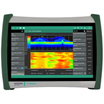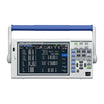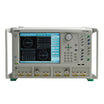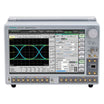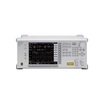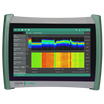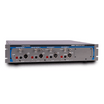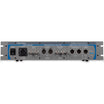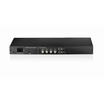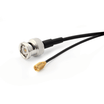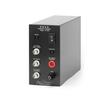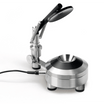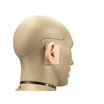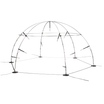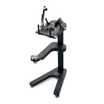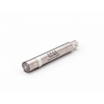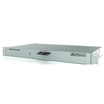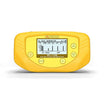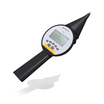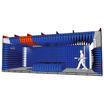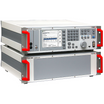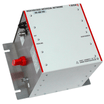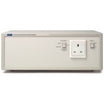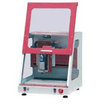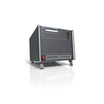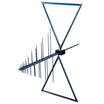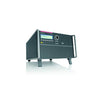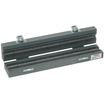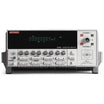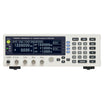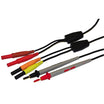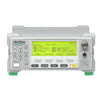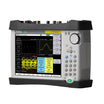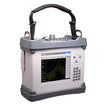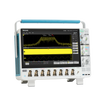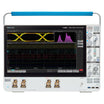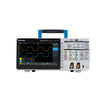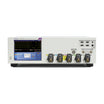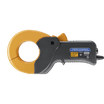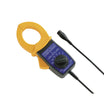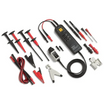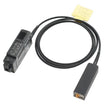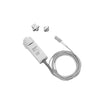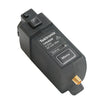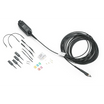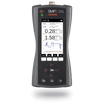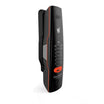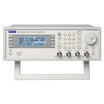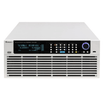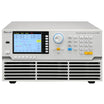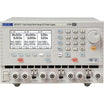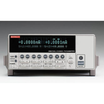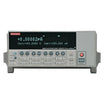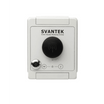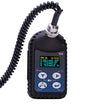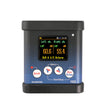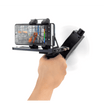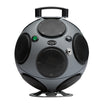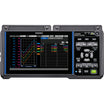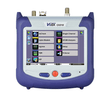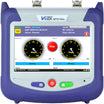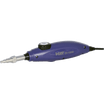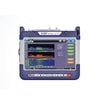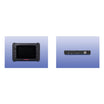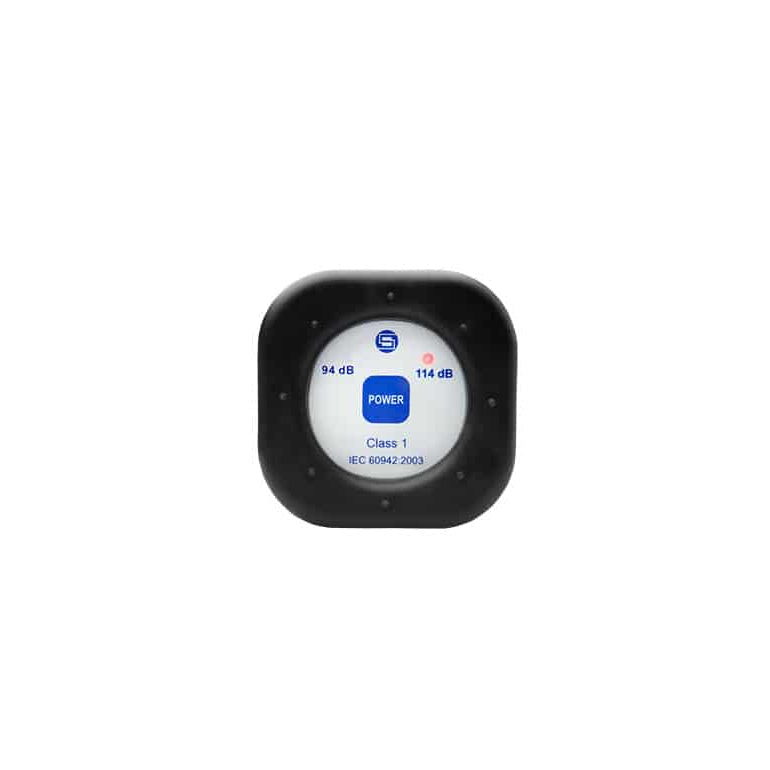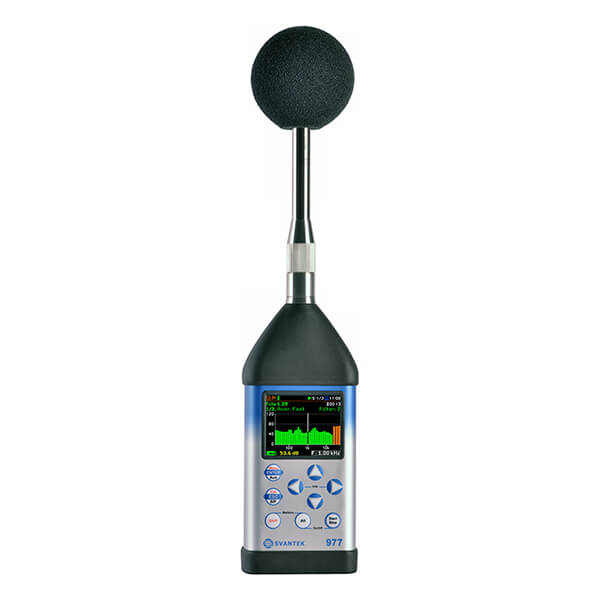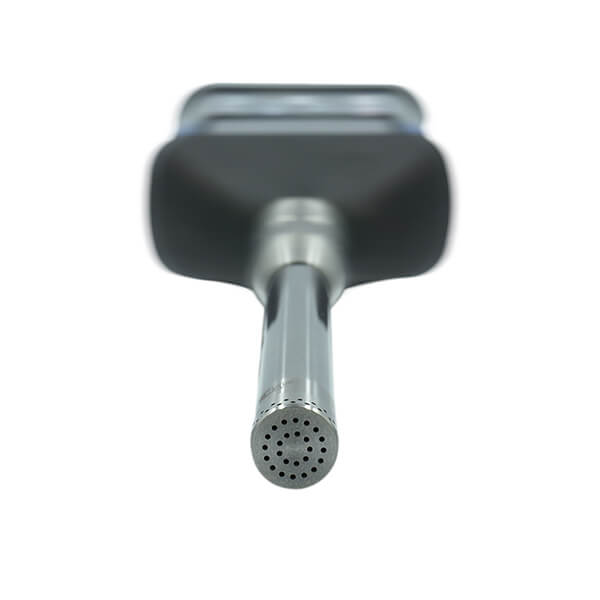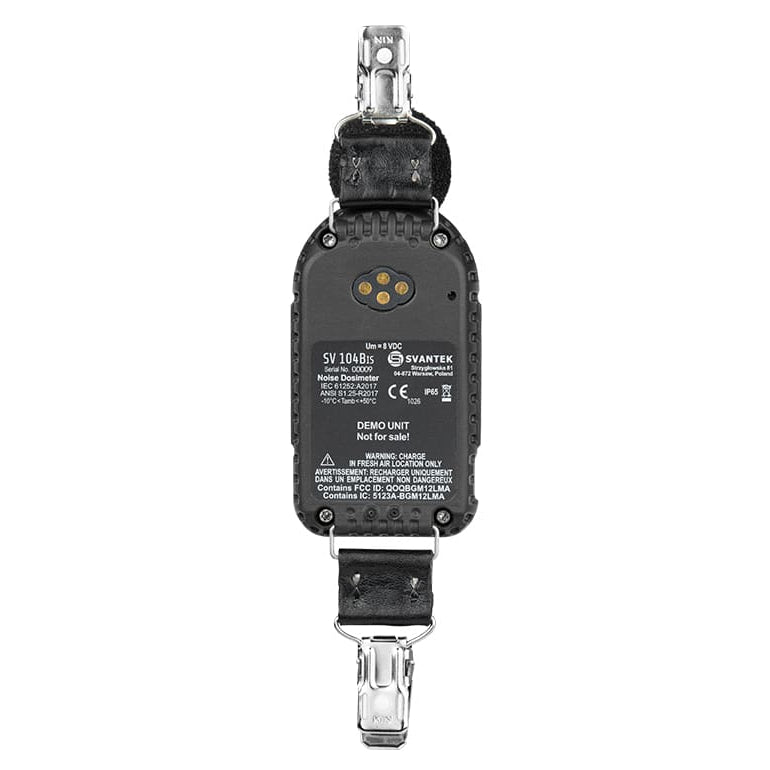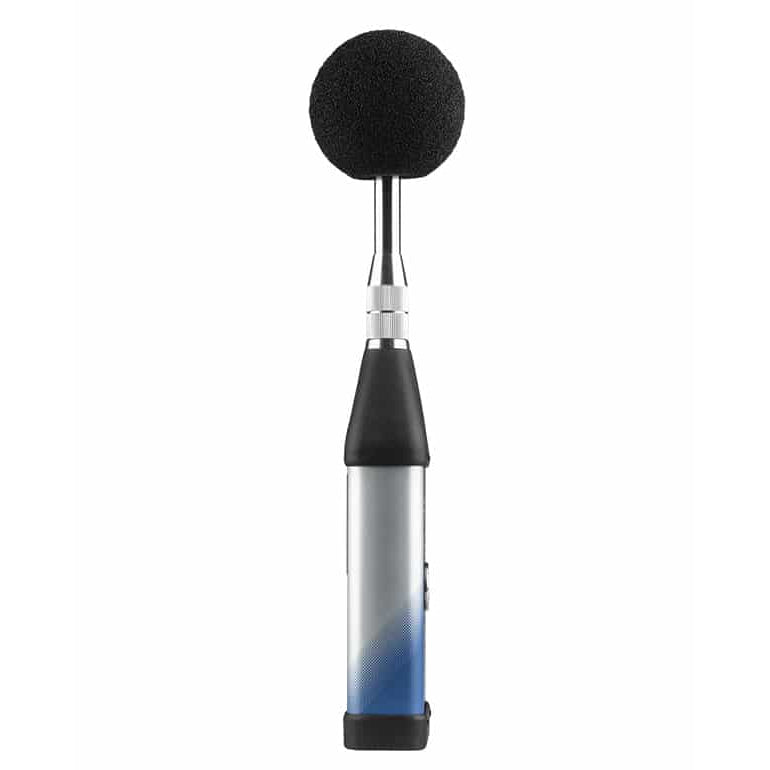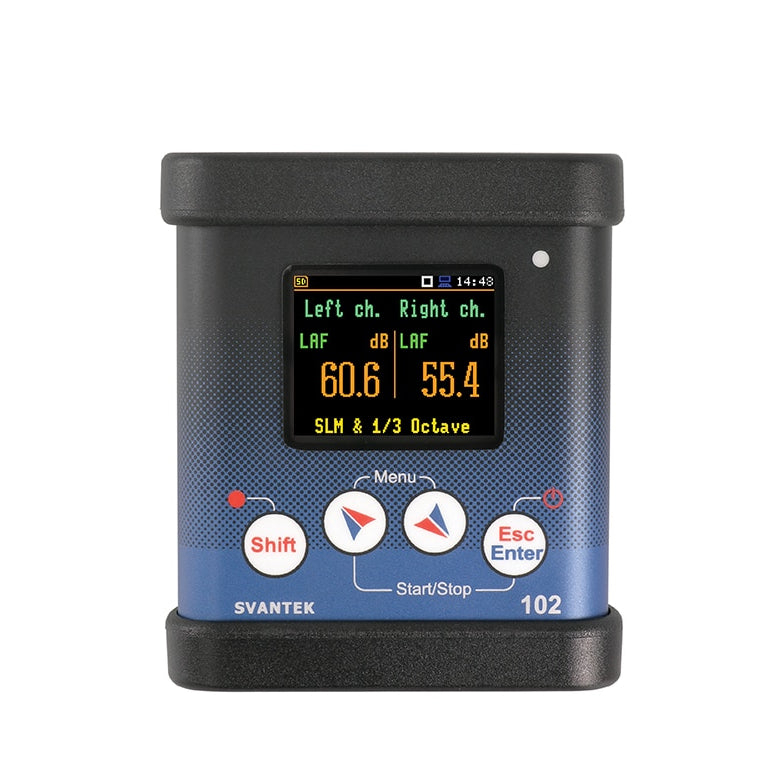

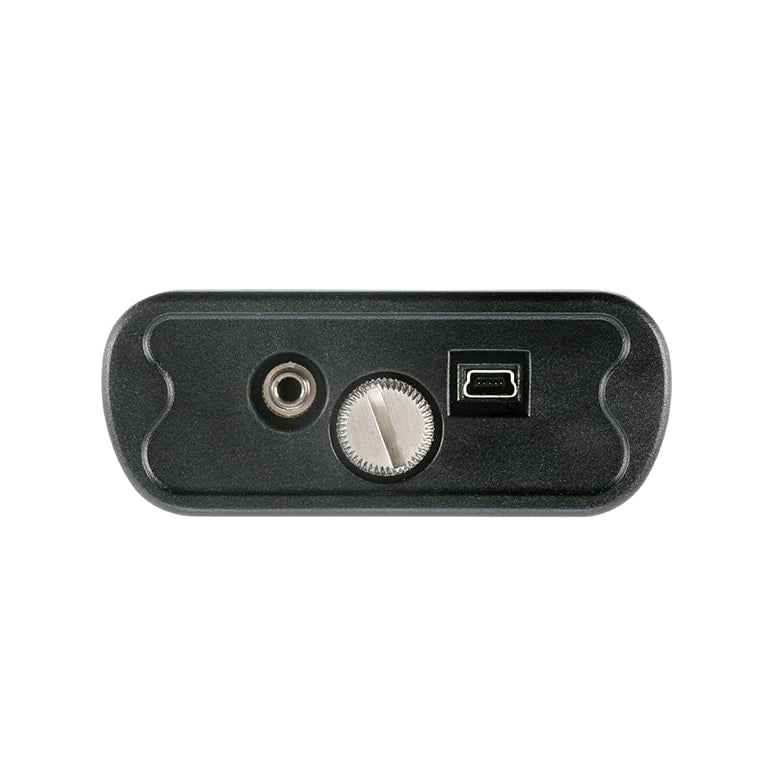
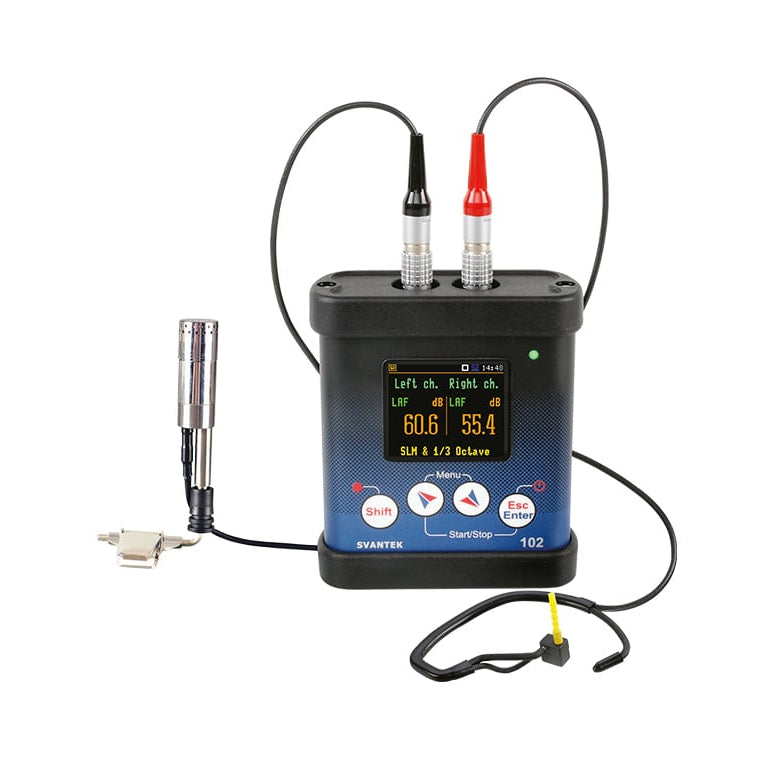
DEMO - Svantek SV 102A+ Klasse 1 Dual-Channel Støjdosimeter
Brug vores chat til personlig support. Eller kontakt os via +45 31 33 18 19 eller Salg@GOmeasure.dk
Standard SV 102A+ Kit inkluderer SV15 -forforstærker med kabel, SV 7052E -mikrofon, 2x AA -batterier, 8 GB hukommelseskort og et USB -kabel til kommunikation med pc. Hver SV 102A+ har sit fabrikskalibreringscertifikat og en 36-måneders garanti ved produktregistrering. Standardsættet inkluderer også licens til pc -software.
Oplev mulighederne
Mere information
Beskrivelse
SV 102A+ er en klasse 1-dobbeltkanals støjdosimeter, der integrerer to forskellige funktionaliteter: dobbeltkanals støjmåling og klasse 1 frekvensområde kapacitet. Den dobbelte kanalfunktion giver mulighed for samtidig støjeksponeringsvurdering på begge sider af hovedet eller i konfigurationer såsom under et headset og på en skulder, hvilket forbedrer nøjagtigheden af støjeksponeringsdata i forskellige arbejdsmiljøer. Denne kapacitet er især fordelagtig til vurdering af asymmetrisk støjeksponering, hvor støj overvejende kan komme fra en retning.
Klasse 1 -nøjagtighed af SV 102A+ betegner dens evne til at måle et fuldt frekvensområde fra 20 Hz til 20 kHz. Dette er en kritisk funktion for arbejdspladser med højfrekvente støjkilder, da standard klasse 2 dosimetre typisk måler op til kun 8 kHz. Det bredere frekvensområde sørger for, at instrumentet opfylder kravene i ISO 9612 til instrumenter i klasse 1, hvilket er vigtigt for nøjagtig støjvurdering på steder, hvor der er en masse højfrekvente støj.
SV 102A+ har også lydoptagelse, der letter uovervågede støjmålinger. Denne kapacitet giver mulighed for afspilning af indspillet støj til at identificere og verificere støjkilder, et krav under ISO 9612 for at skelne arbejdsrelateret støj fra ikke-arbejdsrelaterede støjkilder. Derudover muliggør dosimeters 1/1 oktavanalysefunktion det nøjagtige valg af hørebeskyttere baseret på det specifikke støjmiljø, hvilket yderligere forbedrer arbejdspladsen.
MIRE -måling med SV 102A+
Mire (mikrofon i reel øre) måling er en specialiseret teknik, der bruges med SV 102A+ til vurdering af støjeksponering fra kilder i nærheden af øret, såsom i callcentre, pilothjelme og headset. Denne metode involverer placering af en mikrofon ved indgangen til øregangen for nøjagtigt at fange den støjeksponering, som individet oplever. SV 102A+ understøtter 1/3 oktavanalyse til MIRE-målinger, et krav om at opfylde ISO 11904-1-standarder for genberegning af støjdoser baseret på faktiske støjniveauer inde i øregangen.
Til MIRE -målinger anvender SV 102A+ en høj prøveudtagningshastighed på 48 kHz, der er i overensstemmelse med klasse 1 -instrumenteringsstandarder. Denne høje prøveudtagningshastighed er vigtig for at fange det fulde spektrum af støjfrekvenser, der er stødt på i tætte miljøer, hvilket sikrer nøjagtige og pålidelige støjeksponeringsvurderinger.
Kombinationen af måling af dobbeltkanal, frekvensområde for klasse 1 og MIRE-målingsteknik placerer SV 102A+ som et foretrukket instrument til støjeksponeringsvurdering i militær-, luftfarts- og callcenter-applikationer over hele verden. Dens omfattende træk sikrer, at det opfylder de strenge krav til støjmåling og -analyse inden for disse specialiserede felter.
Hovedfunktioner:
MIRE Målingsteknik
Mikrofon i reelle øremålinger
SV 102A+ anvender ISO 11904-1 MIRE (mikrofon i reel øre) målingsteknik ved anvendelse af en specialiseret mikrofon Probe, SV 25'erne, placeret ved indgangen til øregangen. Denne metode er vigtig for at udføre en tredjedel oktavbåndanalyse direkte inden for øret, hvilket tilbyder præcise støjeksponeringsvurderinger i miljøer, hvor traditionel dosimetri er ineffektiv, såsom callcentre med hovedtelefonbaseret lyd. MIRE-måling er især velegnet til analyse af støjeksponering fra tæt på nærhedskilder, hvilket kræver SV 25S MIRE-mikrofon og 1/3 oktavanalysekapacitet.

Klasse 1 nøjagtighed
Integrering af støjdosimeter og meter på klasse 1 lydniveau
SV 102A+ overholder klasse 1-specifikationerne for IEC 61672, hvilket sikrer målinger med høj præcision på tværs af et bredt frekvensområde fra 20 Hz til 20 kHz. Denne kapacitet er afgørende for nøjagtig støjvurdering i miljøer med højfrekvent støjkilder eller under betingelser med meget lave temperaturer (ned til -10 ° C). Enhedens prøveudtagningshastighed på 48 KHz er i tråd med ISO 9612 -anbefalinger til at fange det fulde spektrum af arbejdspladsstøj og derved give pålidelige data til effektiv støjstyring og høreværn.

Dobbeltkanals input
Samtidige målinger med to mikrofoner
Med to inputkanaler giver SV 102A+ mulighed for den samtidige anvendelse af dobbeltmikrofoner. Denne dobbeltkanalsmetode letter omfattende støjeksponeringsevaluering ved at muliggøre målinger på begge sider af hovedet eller en kombination af en mikrofon placeret på skulderen og en anden inde i øregangen. Sådanne konfigurationer er uvurderlige til at vurdere dæmpningseffektiviteten af hørebeskyttere eller den akustiske præstation af headset, inklusive dem, der bruges i militær luftfart. Denne funktion understreger alsidigheden af SV 102A+ i tilpasning til forskellige målescenarier, hvilket forbedrer dens anvendelighed i erhvervsmæssig støjvurdering.

Hovedansøgning
Erhvervsmæssig støj
Klasse 1 støjmålinger på arbejdspladsen
Erhvervsmæssig støjdosimetri, på linje med standarder som ISO, OSHA og NIOSH, er nøglen til at beskytte arbejdstagere mod skadelig støj. Udfordringen med nøjagtigt måling af støjeksponering kommer fra dens variable og multi-retningsbestemte karakter på arbejdspladsen. SV102A+ dobbeltkanal -dosimeteret adresserer dette ved at tillade samtidige støjmålinger fra forskellige retninger med en enkelt enhed, hvilket gør processen mere effektiv og mindre påtrængende for arbejdstagere. I miljøer som luftfart eller callcentre, hvor støjkilder er komplekse, er traditionelle dosimetri -metoder muligvis ikke tilstrækkelige. Mikrofonen i reelt øre (MIRE) målingsteknik er kritisk her. Mire giver en direkte vurdering af støjeksponering ved øret, hvilket fører til en mere nøjagtig forståelse af auditive risici. Derudover letter SV102A+ uovervåget støjdosimetri med lydoptagelses- og frekvensanalysefunktioner. Disse er vigtige for at analysere støjkilder efter måling, hjælpe med at identificere specifikke støjbidrag og udvikle effektive afbødningsstrategier.

Dokumenter
Datablad:
Muligheder
Video
SV 102A+ er en klasse 1-dobbeltkanals støjdosimeter, der integrerer to forskellige funktionaliteter: dobbeltkanals støjmåling og klasse 1 frekvensområde kapacitet. Den dobbelte kanalfunktion giver mulighed for samtidig støjeksponeringsvurdering på begge sider af hovedet eller i konfigurationer såsom under et headset og på en skulder, hvilket forbedrer nøjagtigheden af støjeksponeringsdata i forskellige arbejdsmiljøer. Denne kapacitet er især fordelagtig til vurdering af asymmetrisk støjeksponering, hvor støj overvejende kan komme fra en retning.
Klasse 1 -nøjagtighed af SV 102A+ betegner dens evne til at måle et fuldt frekvensområde fra 20 Hz til 20 kHz. Dette er en kritisk funktion for arbejdspladser med højfrekvente støjkilder, da standard klasse 2 dosimetre typisk måler op til kun 8 kHz. Det bredere frekvensområde sørger for, at instrumentet opfylder kravene i ISO 9612 til instrumenter i klasse 1, hvilket er vigtigt for nøjagtig støjvurdering på steder, hvor der er en masse højfrekvente støj.
SV 102A+ har også lydoptagelse, der letter uovervågede støjmålinger. Denne kapacitet giver mulighed for afspilning af indspillet støj til at identificere og verificere støjkilder, et krav under ISO 9612 for at skelne arbejdsrelateret støj fra ikke-arbejdsrelaterede støjkilder. Derudover muliggør dosimeters 1/1 oktavanalysefunktion det nøjagtige valg af hørebeskyttere baseret på det specifikke støjmiljø, hvilket yderligere forbedrer arbejdspladsen.
MIRE -måling med SV 102A+
Mire (mikrofon i reel øre) måling er en specialiseret teknik, der bruges med SV 102A+ til vurdering af støjeksponering fra kilder i nærheden af øret, såsom i callcentre, pilothjelme og headset. Denne metode involverer placering af en mikrofon ved indgangen til øregangen for nøjagtigt at fange den støjeksponering, som individet oplever. SV 102A+ understøtter 1/3 oktavanalyse til MIRE-målinger, et krav om at opfylde ISO 11904-1-standarder for genberegning af støjdoser baseret på faktiske støjniveauer inde i øregangen.
Til MIRE -målinger anvender SV 102A+ en høj prøveudtagningshastighed på 48 kHz, der er i overensstemmelse med klasse 1 -instrumenteringsstandarder. Denne høje prøveudtagningshastighed er vigtig for at fange det fulde spektrum af støjfrekvenser, der er stødt på i tætte miljøer, hvilket sikrer nøjagtige og pålidelige støjeksponeringsvurderinger.
Kombinationen af måling af dobbeltkanal, frekvensområde for klasse 1 og MIRE-målingsteknik placerer SV 102A+ som et foretrukket instrument til støjeksponeringsvurdering i militær-, luftfarts- og callcenter-applikationer over hele verden. Dens omfattende træk sikrer, at det opfylder de strenge krav til støjmåling og -analyse inden for disse specialiserede felter.
Hovedfunktioner:
MIRE Målingsteknik
Mikrofon i reelle øremålinger
SV 102A+ anvender ISO 11904-1 MIRE (mikrofon i reel øre) målingsteknik ved anvendelse af en specialiseret mikrofon Probe, SV 25'erne, placeret ved indgangen til øregangen. Denne metode er vigtig for at udføre en tredjedel oktavbåndanalyse direkte inden for øret, hvilket tilbyder præcise støjeksponeringsvurderinger i miljøer, hvor traditionel dosimetri er ineffektiv, såsom callcentre med hovedtelefonbaseret lyd. MIRE-måling er især velegnet til analyse af støjeksponering fra tæt på nærhedskilder, hvilket kræver SV 25S MIRE-mikrofon og 1/3 oktavanalysekapacitet.

Klasse 1 nøjagtighed
Integrering af støjdosimeter og meter på klasse 1 lydniveau
SV 102A+ overholder klasse 1-specifikationerne for IEC 61672, hvilket sikrer målinger med høj præcision på tværs af et bredt frekvensområde fra 20 Hz til 20 kHz. Denne kapacitet er afgørende for nøjagtig støjvurdering i miljøer med højfrekvent støjkilder eller under betingelser med meget lave temperaturer (ned til -10 ° C). Enhedens prøveudtagningshastighed på 48 KHz er i tråd med ISO 9612 -anbefalinger til at fange det fulde spektrum af arbejdspladsstøj og derved give pålidelige data til effektiv støjstyring og høreværn.

Dobbeltkanals input
Samtidige målinger med to mikrofoner
Med to inputkanaler giver SV 102A+ mulighed for den samtidige anvendelse af dobbeltmikrofoner. Denne dobbeltkanalsmetode letter omfattende støjeksponeringsevaluering ved at muliggøre målinger på begge sider af hovedet eller en kombination af en mikrofon placeret på skulderen og en anden inde i øregangen. Sådanne konfigurationer er uvurderlige til at vurdere dæmpningseffektiviteten af hørebeskyttere eller den akustiske præstation af headset, inklusive dem, der bruges i militær luftfart. Denne funktion understreger alsidigheden af SV 102A+ i tilpasning til forskellige målescenarier, hvilket forbedrer dens anvendelighed i erhvervsmæssig støjvurdering.

Hovedansøgning
Erhvervsmæssig støj
Klasse 1 støjmålinger på arbejdspladsen
Erhvervsmæssig støjdosimetri, på linje med standarder som ISO, OSHA og NIOSH, er nøglen til at beskytte arbejdstagere mod skadelig støj. Udfordringen med nøjagtigt måling af støjeksponering kommer fra dens variable og multi-retningsbestemte karakter på arbejdspladsen. SV102A+ dobbeltkanal -dosimeteret adresserer dette ved at tillade samtidige støjmålinger fra forskellige retninger med en enkelt enhed, hvilket gør processen mere effektiv og mindre påtrængende for arbejdstagere. I miljøer som luftfart eller callcentre, hvor støjkilder er komplekse, er traditionelle dosimetri -metoder muligvis ikke tilstrækkelige. Mikrofonen i reelt øre (MIRE) målingsteknik er kritisk her. Mire giver en direkte vurdering af støjeksponering ved øret, hvilket fører til en mere nøjagtig forståelse af auditive risici. Derudover letter SV102A+ uovervåget støjdosimetri med lydoptagelses- og frekvensanalysefunktioner. Disse er vigtige for at analysere støjkilder efter måling, hjælpe med at identificere specifikke støjbidrag og udvikle effektive afbødningsstrategier.


